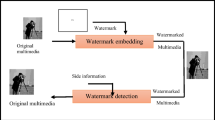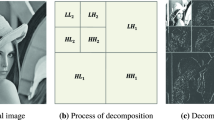Abstract
This research work presents a semi-blind image watermarking scheme based on transforms domain DWT-SVD using an efficient embedding technique. This scheme provides a high level of robustness and imperceptibility for digital image copyright protection. In the embedding process, the watermark data (logo and image in this research) is first transformed into the frequency domain using the DWT algorithm for one pass. Then, the LL-band values are also transformed by the SVD algorithm. S values (diagonal matrix) are prepared for inserting into the cover images. Differently, the cover images (SD and HD quality) are also transformed by DWT for two levels of decomposition. During the insertion process, the watermark bits are embedding into the HL2 and HH2 bands of the cover image using the zigzag technique to improve the imperceptibility. Moreover, the obtained watermarked images are subjected to different attacks (geometric, image processing, and jpeg compression) to show the robustness of the proposed scheme. Finally, the extraction process needs only the watermarked image and the U and V values of SVD transforms (semi-blind watermarking) to reconstruct the original watermark. The performance parameters for the robustness and imperceptibility involved in this work are PSNR and Normalized Correlation Coefficient NCC metrics. Computational cost is also calculated for both embedding and extracting watermark process for different cover image types. Test results indicate that the proposed scheme has a better performance when the watermark data is embedding in a zigzag way.









Similar content being viewed by others
References
Abdallah, Emad E, A Ben Hamza, and Prabir Bhattacharya (2007). “Spectral graph-theoretic approach to 3D mesh watermarking”; Proceedings of Graphics Interface
Abdallah, Emad E, A Ben Hamza, and Prabir Bhattacharya (2009). “Watermarking 3D models using spectral mesh compression”; Signal, image and video processing
Abdallah EE, Hamza AB, Bhattacharya P (2010) Video watermarking using wavelet transform and tensor algebra. SIViP 4(2):233–245
Abraham J, Paul V (2019) An imperceptible spatial domain color image watermarking scheme. Journal of King Saud University-Computer and Information Sciences 31(1):125–133
Arora SM (2018) A DWT-SVD based robust digital watermarking for digital images. Procedia computer science 132:1441–1448
Chrysochos E et al (2014) Hybrid watermarking based on chaos and histogram modification. Signal, Image and Video Processing 8.5:843–857
IS Coaxial (2008), “Digital Watermarking and Steganography.”Morgan Kaufmann Publisher
Ernawan F, Kabir MN (2018) A robust image watermarking technique with an optimal DCT- psychovisual threshold. IEEE Access 6:20464–20480
Fazli S, Moeini M (2016) A robust image watermarking method based on DWT, DCT, and SVD using a new technique for correction of main geometric attacks. Optik 127(2):964–972
Gupta R, Mishra A, Jain S (2018) A semi-blind HVS based image watermarking scheme using elliptic curve cryptography. Multimed Tools Appl 77(15):19235–19260
Hamidi M, Haziti ME, Cherifi H, Hassouni ME (2018) Hybrid blind robust image watermarking technique based on DFT-DCT and Arnold transform. Multimed Tools Appl 77(20):27181–27214
Hurrah, Nasir N., et al (2017). “A transform domain based robust color image watermarking scheme for single and dual attacks.” 2017 Fourth International Conference on Image Information Processing (ICIIP). IEEE
Kumar C, Singh AK, Kumar P (2018) A recent survey on image watermarking techniques and its application in e-governance. Multimed Tools Appl 77(3):3597–3622
Lee Y-S, Seo Y-H, Kim D-W (2019) Blind image watermarking based on adaptive data spreading in n-level DWT subbands. Security and Communication Networks 2019:1–11
Minamoto, Teruya, and Ryuji Ohura (2011). “A non-blind digital image watermarking method based on the dyadic wavelet transform and interval arithmetic.” International Conference on Signal Processing, Image Processing, and Pattern Recognition. Springer, Berlin, Heidelberg
Moeinaddini E, Afsari F (2018) Robust watermarking in DWT domain using SVDand opposition and dimensional based modifiedfireflyalgorithm. Multimed Tools Appl 77.19:26083–26105
Mohammed AA, Ali NA (2018) Robust video watermarking scheme using high efficiency video coding attack. Multimed Tools Appl 77(2):2791–2806
Mohammed, Aree Ali, and Haval Mohammed Sidqi (2011). “Robust image watermarking scheme based on wavelet technique.” IJCSS, Vol.5, Issue.4, Malaysia
Moosazadeh M, GholamhosseinEkbatanifard (2019) A new DCT-based robust image watermarking method using teaching-learning-based optimization. Journal of Information Security and Applications 47:28–38
Nasir I et al (2010) Multiple spatial watermarking technique in color images. SIViP 4(2):145–154
Ntalianis, Klimis S., et al (2002). “Automatic stereoscopic video object-based watermarking using qualified significant wavelet trees.” 2002 Digest of Technical Papers. International Conference on Consumer Electronics (IEEE Cat. No. 02CH37300). IEEE
Pal AK, Roy S (2018) A robust and blind image watermarking scheme in DCT domain. Int J Inf Comput Secur 10(4):321–340
Piva, Alessandro, Roberto Caldelli, and Alessia De Rosa (2000). “A DWT-based object watermarking system for MPEG-4 video streams.” Proceedings 2000 International Conference on Image Processing (Cat. No. 00CH37101). Vol. 3. IEEE
Preda RO, Vizireanu DN (2010) A robust digital watermarking scheme for video copyright protection in the wavelet domain. Measurement 43(10):1720–1726
Rahman, Md Maklachur, et al (2017). “A semi blind watermarking technique for copyright protection of image based on DCT and SVD domain.” Global Journal of Research In Engineering
Rai, Sandeep, et al. (2019). “Digital Image Watermarking Against Geometrical Attack.” Data, Engineering and applications. Springer, Singapore. 129–145
Rasti P, Samiei S, Agoyi M, Escalera S, Anbarjafari G (2016) Robust non-blind color video watermarking using QR decomposition and entropy analysis. J Vis Commun Image Represent 38:838–847
Reddy B, Jadhav A (2015) Visible and Invisible Image Watermarking. IJERT 3.1:1–4
Roy S, Pal AK (2017) A blind DCT based color watermarking algorithm for embedding multiple watermarks. AEU-International Journal of Electronics and Communications 72:149–161
Savakar DG, AnandGhuli (2019) Robust invisible digital image watermarking using hybrid scheme. Arab J Sci Eng 44(4):3995–4008
Savakar DG, Ghuli A (2017) Non-blind digital watermarking with enhanced image embedding capacity using DMeyer wavelet decomposition, SVD, and DFT. Pattern Recognition and Image Analysis 27(3):511–517
C. Shaji and I. Shatheesh Sam (2019). “A new data encoding based on maximum to minimum histogram in reversible data hiding”, of J Imaging Sci, Vol. 67, Issue 4
Singh S, Rathore VS, Singh R, Singh MK (2017) Hybrid semi-blind image watermarking in redundant wavelet domain. Multimed Tools Appl 76(18):19113–19137
Su Q, Chen B (2018) Robust color image watermarking technique in the spatial domain. Soft Comput 22(1):91–106
Tay, R, and JP Havlicek (2002). “Image watermarking using wavelets.” The 2002 45th Midwest Symposium on Circuits and Systems, 2002. MWSCAS-2002.. Vol. 3. IEEE
Vaidya P, Chandra Mouli PVSSR (2017) A robust semi-blind watermarking for color images based on multiple decompositions. Multimed Tools Appl 76(24):25623–25656
Yadav, Bandana, Ashish Kumar, and Yogendera Kumar (2018). “A robust digital image watermarking algorithm using DWT and SVD.” Soft Computing: Theories and applications. Springer, Singapore. 25–36
Zhou X, Zhang H, Wang C (2018) A robust image watermarking technique based on DWT, APDCBT, and SVD. Symmetry 10(3):77
Acknowledgements
This research is a part of the research work between the University of Sulaimani and Halabja in Kurdistan Region of Iraq. Special thanks to the college of science at both universities for providing a healthy environment to fulfill this project. We would also like to express our deep gratitude for generous support and funds by the presidency of Sulaimani and Halabja universities.
Author information
Authors and Affiliations
Corresponding author
Additional information
Publisher’s note
Springer Nature remains neutral with regard to jurisdictional claims in published maps and institutional affiliations.
Rights and permissions
About this article
Cite this article
Mohammed, A.A., Salih, D.A., Saeed, A.M. et al. An imperceptible semi-blind image watermarking scheme in DWT-SVD domain using a zigzag embedding technique. Multimed Tools Appl 79, 32095–32118 (2020). https://doi.org/10.1007/s11042-020-09694-9
Received:
Revised:
Accepted:
Published:
Issue Date:
DOI: https://doi.org/10.1007/s11042-020-09694-9




